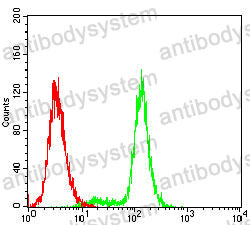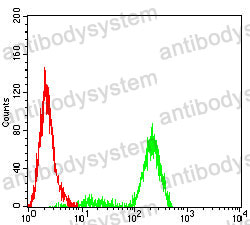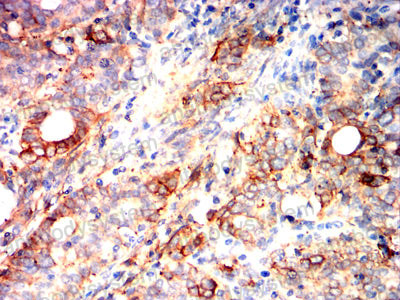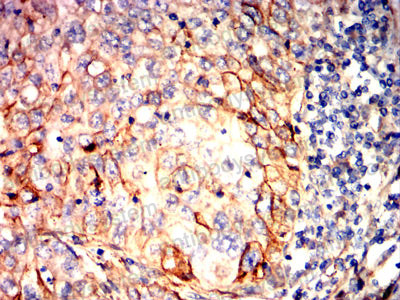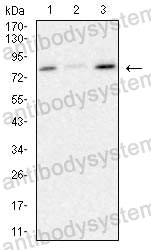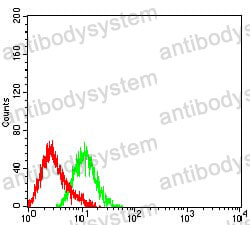Catalog No.
RHK08804
Species reactivity
Human
Host species
Mouse
Isotype
IgG2a
Clonality
Monoclonal
Tested applications
ELISA: 1:10000, FCM: 1:200-1:400, IHC: 1:200-1:1000, WB: 1:500-1:2000
Target
CD36, CLA1, CD36 antigen-like 1, CD36L1, SRB1, Collagen type I receptor, thrombospondin receptor-like 1, SCARB1, Scavenger receptor class B member 1, CLA-1, SR-BI, CD36 and LIMPII analogous 1
Concentration
1 mg/ml
Endotoxin level
Please contact with the lab for this information.
Purity
>95% as determined by SDS-PAGE.
Purification
Protein A/G purified from cell culture supernatant.
Accession
Q8WTV0
Applications
ELISA, FCM, IHC, WB
Form
Liquid
Storage buffer
0.01M PBS, pH 7.4, 0.05% Sodium Azide.
Stability and Storage
Use a manual defrost freezer and avoid repeated freeze-thaw cycles. Store at 4°C short term (1-2 weeks). Store at -20°C 12 months. Store at -80°C long term.
Clone ID
R3Y42
SR-BI regulates the synergistic mast cell response by modulating the plasma membrane-associated cholesterol pool., PMID:38708681
Deletion of the scavenger receptor Scarb1 in osteoblast progenitors does not affect bone mass., PMID:35349600
TNFα-Induced LDL Cholesterol Accumulation Involve Elevated LDLR Cell Surface Levels and SR-B1 Downregulation in Human Arterial Endothelial Cells., PMID:34207810
HDL-scavenger receptor B type 1 facilitates SARS-CoV-2 entry., PMID:33244168
Cisatracurium stimulates testosterone synthesis in rat and mouse Leydig cells via nicotinic acetylcholine receptor., PMID:33111502
Neurotrophin-3 stimulates stem Leydig cell proliferation during regeneration in rats., PMID:33090725
A Neutralizing Antibody Targeting Oxidized Phospholipids Promotes Bone Anabolism in Chow-Fed Young Adult Mice., PMID:32990984
A regulatory role of scavenger receptor class B type 1 in endocytosis and lipid droplet formation induced by liposomes containing phosphatidylethanolamine in HEK293T cells., PMID:32956759
The lipid transfer properties of CETP define the concentration and composition of plasma lipoproteins., PMID:32591337
Scavenger Receptor Class B Type I is Required for 25-Hydroxycholecalciferol Cellular Uptake and Signaling in Myeloid Cells., PMID:32583974
Identification of two major autoantigens negatively regulating endothelial activation in Takayasu arteritis., PMID:32152303
A Recombinant Hepatitis C Virus Genotype 1a E1/E2 Envelope Glycoprotein Vaccine Elicits Antibodies That Differentially Neutralize Closely Related 2a Strains through Interactions of the N-Terminal Hypervariable Region 1 of E2 with Scavenger Receptor B1., PMID:31462563
New Aspects Towards a Molecular Understanding of the Allicin Immunostimulatory Mechanism via Colec12, MARCO, and SCARB1 Receptors., PMID:31344978
Anti-Inflammatory Effects of Different Astaxanthin Isomers and the Roles of Lipid Transporters in the Cellular Transport of Astaxanthin Isomers in Caco-2 Cell Monolayers., PMID:31117505
Nanotherapy for Alzheimer's disease and vascular dementia: Targeting senile endothelium., PMID:29274774
Lipopolysaccharide enters the rat brain by a lipoprotein-mediated transport mechanism in physiological conditions., PMID:29030613
Rational Targeting of Cellular Cholesterol in Diffuse Large B-Cell Lymphoma (DLBCL) Enabled by Functional Lipoprotein Nanoparticles: A Therapeutic Strategy Dependent on Cell of Origin., PMID:28933554
Oxidized LDL activated eosinophil polarize macrophage phenotype from M2 to M1 through activation of CD36 scavenger receptor., PMID:28623741
A decade of progress on the genetic basis of coronary artery disease. Practical insights for the internist., PMID:28395986
Extra-epitopic hepatitis C virus polymorphisms confer resistance to broadly neutralizing antibodies by modulating binding to scavenger receptor B1., PMID:28235087
SR-B1 Is a Silica Receptor that Mediates Canonical Inflammasome Activation., PMID:28147282
Expanding the Host Range of Hepatitis C Virus through Viral Adaptation., PMID:27834208
A Library of Infectious Hepatitis C Viruses with Engineered Mutations in the E2 Gene Reveals Growth-Adaptive Mutations That Modulate Interactions with Scavenger Receptor Class B Type I., PMID:27630236
Lipoprotein Receptors Redundantly Participate in Entry of Hepatitis C Virus., PMID:27152966
Apolipoprotein A-II Plus Lipid Emulsion Enhance Cell Growth via SR-B1 and Target Pancreatic Cancer In Vitro and In Vivo., PMID:27002321
CD36 is a co-receptor for hepatitis C virus E1 protein attachment., PMID:26898231
Novel human anti-claudin 1 mAbs inhibit hepatitis C virus infection and may synergize with anti-SRB1 mAb., PMID:26519290
Scavenger receptor class B, type I-mediated uptake of A1AT by pulmonary endothelial cells., PMID:26092999
Newly identified antiatherosclerotic activity of methotrexate and adalimumab: complementary effects on lipoprotein function and macrophage cholesterol metabolism., PMID:25605003
Intestinal scavenger receptors are involved in vitamin K1 absorption., PMID:25228690
High density lipoprotein stimulated migration of macrophages depends on the scavenger receptor class B, type I, PDZK1 and Akt1 and is blocked by sphingosine 1 phosphate receptor antagonists., PMID:25188469
Selective transfection of microglia in the brain using an antibody-based non-viral vector., PMID:25150592
Role of hypervariable region 1 for the interplay of hepatitis C virus with entry factors and lipoproteins., PMID:25142595
Identification of conserved residues in hepatitis C virus envelope glycoprotein E2 that modulate virus dependence on CD81 and SRB1 entry factors., PMID:24990994
Antibodies to the high-density lipoprotein receptor SR-B1 potently inhibit hepatitis C virus replication in vivo: New avenues for preventing reinfection of the liver following transplantation., PMID:24962233
Rutaecarpine suppresses atherosclerosis in ApoE-/- mice through upregulating ABCA1 and SR-BI within RCT., PMID:24908654
Successful anti-scavenger receptor class B type I (SR-BI) monoclonal antibody therapy in humanized mice after challenge with HCV variants with in vitro resistance to SR-BI-targeting agents., PMID:24797654
Hypervariable region 1 deletion and required adaptive envelope mutations confer decreased dependency on scavenger receptor class B type I and low-density lipoprotein receptor for hepatitis C virus., PMID:24257605
Exosome-mediated transmission of hepatitis C virus between human hepatoma Huh7.5 cells., PMID:23878230
Isolate-dependent use of claudins for cell entry by hepatitis C virus., PMID:23775920
Pharmacokinetics and safety in cynomolgus monkeys of a monoclonal antibody targeting human scavenger receptor class B type-1 for hepatitis C treatment., PMID:23702590
Different requirements for scavenger receptor class B type I in hepatitis C virus cell-free versus cell-to-cell transmission., PMID:23698298
Lymphatic vessels are essential for the removal of cholesterol from peripheral tissues by SR-BI-mediated transport of HDL., PMID:23663736
Impaired serum cholesterol efflux capacity in rheumatoid arthritis and systemic lupus erythematosus., PMID:23562986
Interplay between basic residues of hepatitis C virus glycoprotein E2 with viral receptors, neutralizing antibodies and lipoproteins., PMID:23300734
Antioxidized LDL antibodies are associated with different metabolic pathways in patients with atherosclerotic plaque and type 2 diabetes., PMID:23193212
Novel human SR-BI antibodies prevent infection and dissemination of HCV in vitro and in humanized mice., PMID:22414763
Therapeutic effects of combination using glucosamine plus tacrolimus (FK-506) on the development of atopic dermatitis-like skin lesions in NC/Nga mice., PMID:22023698
C323 of SR-BI is required for SR-BI-mediated HDL binding and cholesteryl ester uptake., PMID:21917726
A genetically humanized mouse model for hepatitis C virus infection., PMID:21654804

